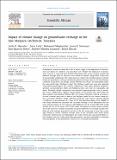| dc.description.abstract | Groundwater account for about 60 to 80% of water supply to the population of Tanzania's semi-arid regions for domestic and agriculture uses. Despite the importance of groundwater resource in semi-arid areas, limited information exists on the recharge amount and potential recharge zones in Tanzania in the context of climate change which could result in unsustainable withdrawals. This study aimed to estimate the potential impact of climate change on groundwater recharge and identify potential recharge zones in the Lake Manyara catchment using Water and Energy Transfer between Soil, Plants and Atmosphere under the quasi-steady State (WetSpass) model. The WetSpass model was setup and calibrated using hydro-meteorological data (rainfall, temperature, wind speed, potential evapotranspiration, and groundwater depth) and biophysical data (soil, land use, topography, and slope). Simulated rainfall, temperature and potential evapotranspiration from an ensemble of four CORDEX-Africa regional climate models for the period 2021–2050 under the Representative Concentration Pathway (RCP 8.5) scenario (hereafter referred as business-as-usual scenario) were used as input in the WetSpass model for the climate change impact assessment. WetSpass model calibration using the water balance equation showed a coefficient of determination (R2) value of 0.9 and Root-Mean-Square Error (RMSE) of 0.49 mm/yr between the simulated and calculated recharge. It was determined that the mean annual recharge of 53.9 mm/year (149 MCM/year) for the period 1989–2018 would increase by 7.9% in the future (2021–2050) under the business-as-usual climate scenario, due to the increase in rainfall. Seasonality and spatial differences in recharge amount were observed, with recharge projected to increase in the dry season and at areas that receive high amount of rainfall. Potential recharge zones in the catchment were found mostly around the northern part near Ngorongoro, the south-western part, and around Mbulu region. Findings from this study would help policymakers, and local stakeholders in planning and management of the groundwater resources for sustainable development. | en_US |

